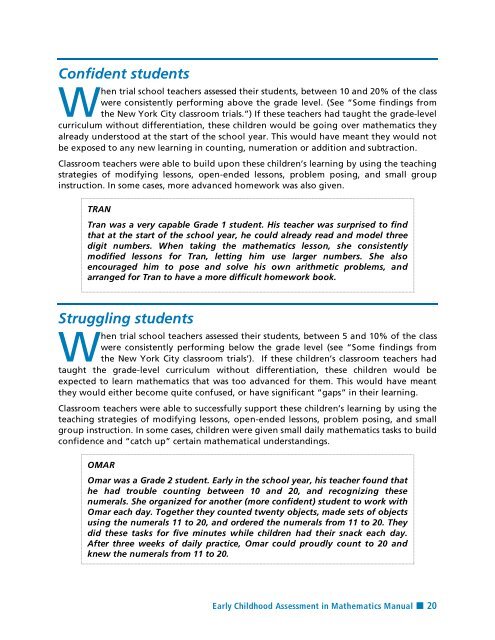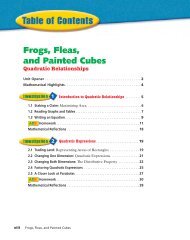ECAM-Manual-and-Resources
ECAM-Manual-and-Resources
ECAM-Manual-and-Resources
Create successful ePaper yourself
Turn your PDF publications into a flip-book with our unique Google optimized e-Paper software.
Confident students<br />
W<br />
hen trial school teachers assessed their students, between 10 <strong>and</strong> 20% of the class<br />
were consistently performing above the grade level. (See “Some findings from<br />
the New York City classroom trials.”) If these teachers had taught the grade-level<br />
curriculum without differentiation, these children would be going over mathematics they<br />
already understood at the start of the school year. This would have meant they would not<br />
be exposed to any new learning in counting, numeration or addition <strong>and</strong> subtraction.<br />
Classroom teachers were able to build upon these children’s learning by using the teaching<br />
strategies of modifying lessons, open-ended lessons, problem posing, <strong>and</strong> small group<br />
instruction. In some cases, more advanced homework was also given.<br />
TRAN<br />
Tran was a very capable Grade 1 student. His teacher was surprised to find<br />
that at the start of the school year, he could already read <strong>and</strong> model three<br />
digit numbers. When taking the mathematics lesson, she consistently<br />
modified lessons for Tran, letting him use larger numbers. She also<br />
encouraged him to pose <strong>and</strong> solve his own arithmetic problems, <strong>and</strong><br />
arranged for Tran to have a more difficult homework book.<br />
Struggling students<br />
W<br />
hen trial school teachers assessed their students, between 5 <strong>and</strong> 10% of the class<br />
were consistently performing below the grade level (see “Some findings from<br />
the New York City classroom trials’). If these children’s classroom teachers had<br />
taught the grade-level curriculum without differentiation, these children would be<br />
expected to learn mathematics that was too advanced for them. This would have meant<br />
they would either become quite confused, or have significant “gaps” in their learning.<br />
Classroom teachers were able to successfully support these children’s learning by using the<br />
teaching strategies of modifying lessons, open-ended lessons, problem posing, <strong>and</strong> small<br />
group instruction. In some cases, children were given small daily mathematics tasks to build<br />
confidence <strong>and</strong> “catch up” certain mathematical underst<strong>and</strong>ings.<br />
OMAR<br />
Omar was a Grade 2 student. Early in the school year, his teacher found that<br />
he had trouble counting between 10 <strong>and</strong> 20, <strong>and</strong> recognizing these<br />
numerals. She organized for another (more confident) student to work with<br />
Omar each day. Together they counted twenty objects, made sets of objects<br />
using the numerals 11 to 20, <strong>and</strong> ordered the numerals from 11 to 20. They<br />
did these tasks for five minutes while children had their snack each day.<br />
After three weeks of daily practice, Omar could proudly count to 20 <strong>and</strong><br />
knew the numerals from 11 to 20.<br />
Early Childhood Assessment in Mathematics <strong>Manual</strong> ■ 20



